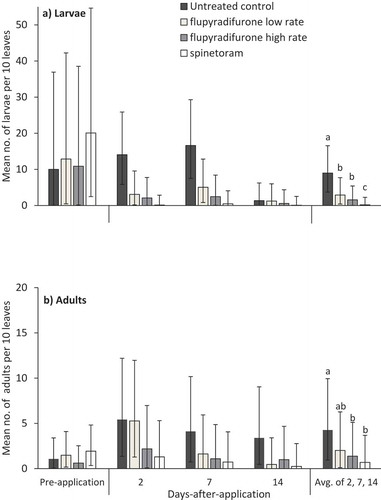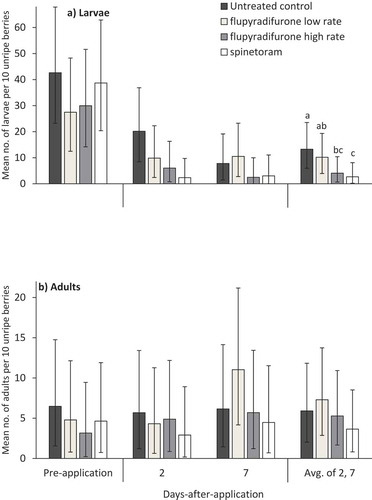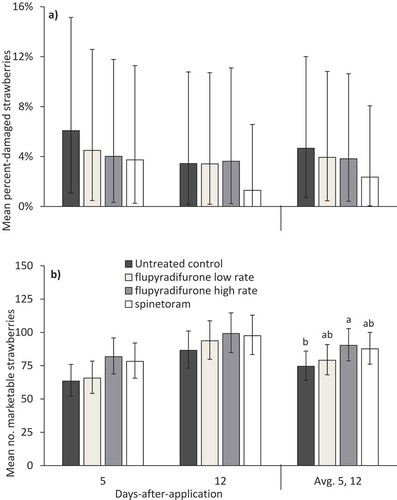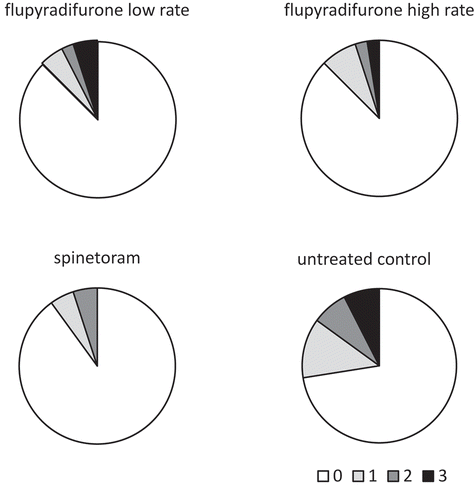ABSTRACT
Scirtothrips dorsalis Hood is a pest of strawberry in Florida, causing foliar and fruit damage to young plants. A field-plot study was conducted in 2015–16 to compare the efficacy of flupyradifurone (SivantoTM 200 SL, 1035 and 2070 ml ha−1) to spinetoram (Radiant SC®, 740 ml ha−1). Flupyradifurone reduced S. dorsalis by 68-83% on leaves and unripe fruit but was not as effective as spinetoram. More plants in control (25%) than insecticide-treated plots (10-15%) had S. dorsalis damage. The yield was increased by the high rate of flupyradifurone, but percent thrips-damaged strawberries were not affected. With modest activity against S. dorsalis, flupyradifurone may be best used after a highly effective thrips insecticide when a follow-up application is needed.
Introduction
Scirtothrips dorsalis Hood (Thysanoptera: Thripidae) is an invasive, polyphagous pest of vegetable, ornamental and fruit crops and has been recorded from 225 host plant species (Mound and Palmer, Citation1981; Seal et al., Citation2010; Venette and Davis, Citation2004). The most susceptible crop hosts are pepper, KnockOut® rose, cotton, peanut, tea, grapes, citrus, mango, strawberry and blueberry (Seal et al., Citation2010; Venette and Davis, Citation2004). Adults and larvae of S. dorsalis damage young plant tissue by removing cell contents using piercing-sucking mouthparts. Originating in southern Asia, S. dorsalis has spread extensively through trade and is currently found in many regions of east Asia, Oceania, Africa and Americas but not yet in Europe (Kumar et al., Citation2011). In the USA, S. dorsalis was first found in Florida in 2005 on ornamental plants in retail stores (Hodges et al., Citation2005), and by 2007 it was recorded in various crops in much of the state (Diffie et al., Citation2008).
Mitigating losses due to S. dorsalis is becoming an increasingly important issue in Florida strawberry production. Adult S. dorsalis are first found on new growth of strawberry plants in October, a few weeks after planting. As in other crops, adults likely disperse into fields from surrounding vegetation (Masui, Citation2007). Females oviposit in young leaf tissue, and developing larvae can cause serious damage to small plants. Damage progresses from mild darkening of leaf veins and petioles to extensive curling, darkening and hardening of leaf tissue (). Severely damaged plants fail to produce marketable fruit, and S. dorsalis larvae feed on ripening fruit, causing bronzing and cracking of ripe fruit.
Figure 1. Progression of damage (left to right) on strawberry leaves caused by Scirtothrips dorsalis Hood feeding injury. Photo credits: Babu Panthi, University of Florida.

Currently, control decisions are made when S. dorsalis damage symptoms are first noticed in young strawberry plants, and foliar insecticides are applied regularly during the following weeks or months. Repeated application of insecticides may lead to the development of insecticide resistance, as has occurred with S. dorsalis in other crops (Gao et al., Citation2012; Reddy et al., Citation1992; Vanisree et al., Citation2011), increased input costs resulting from repeat applications that may not be necessary, and potential harm of beneficial insects that provide natural biological control and pollination services. Insecticides effective against thrips and commonly used in Florida strawberry include spinosyns (IRAC Mode of Action (MOA) group 5: spinetoram and spinosad), neonicotinoids (IRAC MOA group 4A: imidacloprid, acetamiprid, thiamethoxam), and occasionally benzoylureas (IRAC MOA group 15: novaluron), pyrethroids (IRAC MOA group 3A: bifenthrin, pyrethrins) or organophosphates (IRAC MOA group 1B: malathion) (Seal and Kumar, Citation2010). As S. dorsalis has become a significant pest in Florida strawberry in recent years, a greater number of early-season insecticide applications are being used, leaving fewer applications of highly effective thrips-control products for flower thrips (Frankliniella spp.) later in the season. To diversify the thrips-management toolbox, newer insecticides including diamides (IRAC MOA group 28: chlorantraniliprole and cyantraniliprole), sulfoximines (IRAC MOA group 4 C: sulfoxaflor), and pre-mixes of chlorantraniliprole + thiamethoxam and cyantraniliprole + abamectin are labeled for use or are being tested in strawberry. The objective of this study was to determine efficacy of an additional new insecticide, flupyradifurone (Sivanto™ 200 SL), against S. dorsalis.
Flupyradifurone is the only insecticide in the newly-designated butenolides subclass (IRAC MOA group 4 subclass D). Flupyradifurone was derived from the natural product stemofoline, purified from the medicinal plant Stemona japonica (Blume) Miq (Stemonaceae) (Nauen et al., Citation2015). It acts on insect nicotinic acetylcholine receptors like other neonicotinoids but is structurally unique, working at a different binding site and showing activity on neonicotinoid-resistant insects (Hesselbach and Scheiner, Citation2018; Nauen et al., Citation2015). Flupyradifurone is active by ingestion and contact and is systemic in plants and has translaminar activity (Jeschke et al., Citation2015), making it suitable for foliar and soil applications (Nauen et al., Citation2015). Flupyradifurone is a reduced-risk insecticide as it is nontoxic to honeybees but is fast-acting on a number of sucking pests, including aphids, whiteflies and Asian citrus psyllid, Diaphorina citri Kuwayama (Chen et al., Citation2017; Nauen et al., Citation2015).
Materials and Methods
Flupyradifurone was tested in strawberry field plots at the Gulf Coast Research and Education Center, Balm FL (27°45ʹ43”N 82°13ʹ38”W). Bare-root strawberry transplants (cv. ‘Radiance’) from a nursery in Nova Scotia, Canada were set 14 Oct 2015 (38 cm in row spacing) in two rows in raised, double-pressed beds (1.2 m spacing) covered with virtually impermeable film (BlockadeTM, Berry Plastics, Evansville, IN, USA) that were fumigated with a soil fungicide/nematicide (Telone® C-35, 280 L ha−1, Dow AgroSciences, Indianapolis, IN, USA) at bed formation on 20 Aug 2015. A glyphosate-based herbicide (Round-up®, 48.7%, Monsanto Company, St. Louis, MO, USA) was applied to row aisles before transplanting. Plants were overhead irrigated for 10 days during daytime hours following transplanting and drip fertigated at recommended rates starting in November (Whitaker et al., Citation2017). Plants received weekly applications of fungicides (primarily Captan® 80 WDG, 6.7 kg ha−1, Drexel Chemical Company, Memphis, TN, USA) to control strawberry diseases such as botrytis fruit rot, anthracnose fruit rot and powdery mildew. One early-season application of Bacillus thuringiensis-based biopesticide (DiPel® DF, 1120 g ha−1, Valent Biosciences, Libertyville, IL, USA) was made to control lepidopteran larvae; DiPel® has no known activity against thrips.
Plots (10 m × 1 raised bed) were arranged in a randomized complete block design with four replications in two adjacent raised beds (95 m long). There was an unplanted buffer of 1 m between plots and 2 m between blocks. Insecticides were applied on 23 Dec 2015 when symptoms of S. dorsalis injury – darkened, reddish-brown petioles and leaf veins – were evident. Flupyradifurone (Sivanto™ 200 SL, 17.09%, Bayer CropScience, Research Triangle Park NC, USA) was applied at a low and high rate (1035 and 2070 ml ha−1) and compared to spinetoram (Radiant® SC, 11.7%, Dow AgroSciences, Indianapolis, IN, USA), at the highest label rate (740 ml ha−1) and a water-only control. Applications of treatments were made once with one over-the-top pass using a double-nozzle (Systems CO2 trigger, TeeJet® Technologies, Springfield, IL) hand-held wand sprayer connected to a CO2-powered backpack sprayer (414 kPa at 934 L ha−1).
Insecticide efficacy was evaluated by removing one young trifoliate leaf and one small, green strawberry from 10 randomly selected plants per plot on 22 (pre-insecticide application), 25 (2 days-after-application), and 30 Dec 2015 (7 days-after-application) and 6 Jan 2016 (14 days-after-application), placing leaves and fruit (separately) into sealed plastic containers (500 mL) to dislodge thrips. In the laboratory, 70% ethanol was poured into containers, and after 1 h leaves or fruit were rinsed with ethanol and removed. Adult and larval S. dorsalis were identified and counted using a stereomicroscope. In addition, 10 plants per plot were rated on 22 Dec 2015 (pre-insecticide application) and on 6 Jan 2016 (14 days-after-application) for S. dorsalis injury symptoms. Each plant was given a score of 0 = no visible symptoms; 1 = up to 25% of petioles/leaves showing symptoms; 2 = 26 to 50%; 3 = 51 to 75%; 4 = more than 75% of leaves with symptoms. All ripe berries from each treatment plot were harvested on 28 Dec 2015 (5 days-after-application) and on 4 Jan 2016 (12 days-after-application), and the number of marketable and thrips-damaged berries (bronzing, scarring, cracking) were counted.
Statistical Analysis
Mixed-model analyses of variance (ANOVA) were used to determine if insecticide applications caused differences in numbers of adult and larval S. dorsalis on leaves and fruits and in numbers of marketable and thrips-damaged fruits. Sample date was a repeated measure, pre-application samples were analyzed separately, and block was a random effect. Data were square-root transformed to satisfy ANOVA assumptions, and back-transformed means and 95% confidence intervals are reported. Means were compared with a Tukey’s post hoc HSD test (P < 0.05). Fisher’s exact test was used to compare proportions of plants among insecticide treatments with varying damage ratings (P < 0.05). All analyses were conducted using JMP statistical software (SAS Institute Inc., Citation2018) at α = 0.05.
Results
There were no differences in numbers of S. dorsalis larvae (F3,9 = 0.19; P = 0.90) or adults (F3,9 = 0.52; P = 0.68) on leaves or of adults (F3,9 = 0.33; P = 0.80) or larvae (F3,9 = 0.90; P = 0.48) on unripe strawberries among plots pre-insecticide application.
Numbers of S. dorsalis larvae and adults on leaves were affected consistently across sampling dates (insecticide*date interaction, P > 0.05) by insecticides (). Both rates of flupyradifurone resulted in fewer larvae than in control plots, and spinetoram resulted in fewer larvae than both flupyradifurone rates (). The high rate of flupyradifurone and spinetoram resulted in fewer adults than in control plots ().
Table 1. Results of analysis of variance for the effects of insecticide applications and sample date on numbers of larval and adult Scirtothrips dorsalis Hood on strawberry leaves and unripe/green fruit and on numbers of marketable and thrips-damaged fruit in research plots in Balm FL.
Figure 2. Mean (± 95% CI) Scirtothrips dorsalis Hood (a) larvae and (b) adults pre- (22 Dec 2015) and post-application of flupyradifurone (Sivanto™ 200 SL) at a low or high rate (1035, 2070 ml ha−1) or spinetoram (Radiant® SC, 740 ml ha−1) (23 Dec 2015) (25, 30 Dec 2015, 6 Jan 2016) on 10 young strawberry leaves in field research plots in Balm FL. Bars with the same letters are not significantly different (Tukey’s HSD test, P < 0.05).

Numbers of S. dorsalis larvae on unripe strawberries was affected consistently across sampling dates by insecticides, but numbers of adults were not affected (). The high rate of flupyradifurone resulted in fewer larvae than in control plots, and spinetoram resulted in fewer larvae than in control plots and those with a low rate of flupyradifurone ().
Figure 3. Mean (± 95% CI) Scirtothrips dorsalis Hood (a) larvae and (b) adults pre- (22 Dec 2015) and post-application of flupyradifurone (Sivanto™ 200 SL) at a low or high rate (1035, 2070 ml ha−1) or spinetoram (Radiant® SC, 740 ml ha−1) (23 Dec 2015) (25, 30 Dec 2015) on 10 small, unripe strawberries in field research plots in Balm FL. Bars with the same letters are not significantly different (Tukey’s HSD test, P < 0.05).

Percentage of thrips-damaged strawberries due to S. dorsalis injury (cracking, bronzing) was not affected by insecticides, but the number of marketable strawberries was affected (). Yield was higher in plots with the high rate of flupyradifurone compared to control plots but did not differ from plots with the low rate of flupyradifurone or spinetoram ().
Figure 4. Mean (± 95% CI) (a) Scirtothrips dorsalis Hood damaged strawberries and (b) marketable strawberries 5 and 12 days post-application (28 Dec 2015, 4 Jan 2016) of flupyradifurone (Sivanto™ 200 SL) at a low or high rate (1035, 2070 ml ha−1) or spinetoram (Radiant® SC, 740 ml ha−1) (23 Dec 2015) from field research plots in Balm FL. Bars with the same letters are not significantly different (Tukey’s HSD test, P < 0.05).

Proportions of plants assigned damage ratings based on symptoms of S. dorsalis feeding injury were not significantly different among plots pre-insecticide application (P = 0.71) or 14 days after insecticide application (P = 0.59). By 14 days, more than 25% of plants in control plots had damage, whereas only 10 to 15% of plants in insecticide-treated plots were damaged, with few plants having severe symptoms ().
Figure 5. Strawberry plant (n = 40) ratings (0 = no visible symptoms; 1 = up to 25%; 2 = 26 to 50%; 3 = 51 to 75% of petioles/leaves per plant with symptoms) for bronzed, reddish-brown petioles and leaves due to Scirtothrips dorsalis feeding injury 14 days post-application (6 Jan 2016) of flupyradifurone (Sivanto™ 200 SL) at a low or high rate (1035, 2070 ml ha−1) or spinetoram (Radiant® SC, 740 ml ha−1) (23 Dec 2015) in field research plots in Balm FL.

Discussion
Our results showed that a foliar application of flupyradifurone in strawberry reduced S. dorsalis, but that flupyradifurone was not as effective as spinetoram. On pepper plants, flupyradifurone (730 ml ha−1) reduced S. dorsalis larvae and adults by 94% and 87%, respectively, at 10 days after application (Kumar et al., Citation2017), compared to a 78% reduction in larvae on leaves two days after application of the low rate (1035 ml ha−1) in this study. Comparatively, spinetoram-reduced S. dorsalis larvae by >99% on leaves two days after application, and low numbers of S. dorsalis on leaves and unripe fruit (reductions in adults on unripe fruit was not significantly lower) persisted for 7 and 14 days after application. Kumar et al. (Citation2017) found spinetoram caused 91 to 99% S. dorsalis mortality in pepper plants in greenhouse and field scenarios, and spinetoram was effective against S. dorsalis in other studies (Cluever et al., Citation2016; Seal and Kumar, Citation2010). Since flupyradifurone offers a unique mode of action and is the only member of the new IRAC subclass 4D, it should be a good rotation partner with spinosyns or diamides if a subsequent application is needed for S. dorsalis after an initial insecticide application. In its native range, S. dorsalis resistance to organochlorine, organophosphate and carbamate insecticides has been found (Reddy et al., Citation1992; Vanisree et al., Citation2011), and thus it is necessary to evaluate new insecticides and integrate them into a management strategy in Florida strawberry to minimize the risk of resistance developing to overuse of a single insecticide/insecticidal mode of action.
Doubling the rate of flupyradifurone (1035 to 2070 ml ha−1) provided only minor improvements in efficacy, and spinetoram was still superior. Across sampling dates, the high rate was 45% and 60% better than the low flupyradifurone rate at controlling larvae on leaves and unripe fruit, respectively. The high rate resulted in the greatest marketable yield, significantly more than the control by about 16 strawberries and more than spinetoram-treated plots by about three strawberries, even though percent thrips-damaged strawberries was not affected by insecticide, but lowest (50% less than control) in spinetoram-treated plots. Bronzed, cracked and small strawberries were also likely due to flower thrips (Franklinella spp.) feeding injury (Strzyzewski, Citation2017). Flower thrips are common in Florida strawberry, and spinetoram is also highly effective against them (Cluever et al., Citation2016; Justin Renkema, unpublished data). Flupyradifurone is effective on aphids and whiteflies, that were present but not sampled, for which spinetoram is not recommended. Therefore, the presence of other pests and differential effects of flupyradifurone and spinetoram on other pests likely decoupled a direct relationship between yield and bronzed, cracked and small strawberries attributed to S. dorsalis. Finally, the maximum application rate for flupyradifurone is 1035 ml ha−1 in strawberry with a maximum yearly amount of 2070 ml ha−1, meaning two subsequent applications of flupyradifurone would be needed but may not be economically feasible given the modest rates of control achieved at single high rate application.
Scirtothrips dorsalis populations pre-insecticide application were low at two adults or fewer per 10 leaves. A threshold for S. dorsalis in strawberry has not been established but is 1–5 adults per leaf depending on the crop and leaf area (Aristizábal et al., Citation2016; Seal et al., Citation2006). Furthermore, S. dorsalis populations decreased during the experiment, with particularly low larval numbers in control plots 14 days after application (6 Jan 2016). Minimum temperatures of ~7.5°C for two consecutive nights (4, 5 Jan 2016) (FAWN, Citation2019) below the development threshold of 9.7°C (Shibao, Citation1996) may have slowed larval development/caused some mortality, contributing to the S. dorsalis decline. Therefore, there is an opportunity for future management programs for S. dorsalis in Florida strawberry to be built around population modeling, as actual or forecasted low temperatures may limit population growth/cause mortality and reduce damage to fruit, resulting in the need for fewer insecticide applications.
As the Florida strawberry industry shifts toward increasing early-season production (Nov – Dec) by planting earlier (mid-late Sep vs. early Oct) and using plug or tray instead of bare-root plants, there is a high likelihood that S. dorsalis, which thrive in the hot, humid autumn climate of central Florida, will continue to increase its negative impact on strawberry production. Moderate efficacy of flupyradifurone on S. dorsalis complements its efficacy against aphids and whiteflies and represents an additional tool in a thrips management program. Additional experiments should be conducted with flupyradifurone early in the season (Oct – mid Nov) when S. dorsalis is a primary concern, as younger, smaller plants are more susceptible to injury and damage compared to larger plants in (late Dec – early Jan) in this study. Using flupyradifurone early in the season for S. dorsalis will mean an application of a more thrips-potent insecticide (e.g., acetamiprid, cyantraniliprole) can be reserved for flower thrips, which typically need to be controlled for the majority of the growing season (mid Nov – Feb).
Acknowledgments
We thank Shashan Devkota, Emily Vasquez, Deborah Farr and Mark Santos for field assistance and Bayer CropScience for providing funding. We thank Dr. Sriyanka Lahiri for comments on the manuscript.
Literature cited
- Aristizábal, L.F., G.M. Mascarin, R.H. Cherry, B. Chaves-Cordoba, and S.P. Arthurs. 2016. A rapid sampling plan for Scirtothrips dorsalis (Thysanoptera: Thripidae) on container shrub rose (Rosa ’Radrazz’). J. Econ. Entomol. 109(6):2543–2550. doi: 10.1093/jee/tow231.
- Chen, X.D., M. Seo, and L.L. Stelinski. 2017. Behavioral and hormetic effects of the butenolide insecticide, flupyradifurone, on Asian citrus psyllid, Diaphorina citri. Crop Prot. 98:102–107. doi: 10.1016/j.cropro.2017.03.017.
- Cluever, J.D., H.A. Smith, C.A. Nagle, J.E. Funderburk, and G. Frantz. 2016. Effect of insecticide rotations on density and species composition of thrips (Thysanoptera) in Florida strawberry (Rosales: Rosaceae). Fla. Entomol. 99(2):203–209. doi: 10.1653/024.099.0208.
- Diffie, S., G.B. Edwards, and L.A. Mound. 2008. Thysanoptera of southeastern USA: A checklist for Florida and Georgia. Zootaxa. 1787:45–62. doi: 10.11646/zootaxa.1787.1.3.
- FAWN. 2019. Florida automated weather network. University of Florida. 20 Mar. 2019. https://fawn.ifas.ufl.edu/data/
- Gao, Y., Z. Lei, and S.R. Reitz. 2012. Western flower thrips resistance to insecticides: Detection, mechanisms and management strategies. Pest Manag. Sci. 68(8):1111–1121. doi: 10.1002/ps.3305.
- Hesselbach, H., and R. Scheiner. 2018. Effects of the novel pesticide flupyradifurone (Sivanto) on honeybee taste and cognition. Sci. Rep. 8(1):4954. doi: 10.1038/s41598-018-23200-0.
- Hodges, G., G.B. Edwards, and W. Dixon. 2005. Chilli thrips, Scirtothrips dorsalis Hood (Thysanoptera: Thripidae), a new pest thrips for Florida. Pest alert FDACS-P-01660. Florida Department of Agriculture and Consumer Service, Department of Primary Industries.
- Jeschke, P., M. Haas, R. Nauen, O. Gutbrod, M.E. Beck, S. Matthiesen, and R. Velten. 2015. Sivanto® - A novel insecticide with a sustainable profile, p. 331–344. In: Discovery and synthesis of crop protection products, ACS symposium series. american chemical society. doi:10.1021/bk-2015-1204.ch024.
- Kumar, V., G. Kakkar, D.R. Seal, C.L. McKenzie, and L.S. Osborne. 2017. Evaluation of Insecticides for curative, preventive, and rotational use on Scirtothrips dorsalis South Asia 1 (Thysanoptera: Thripidae). Fla. Entomol. 100(3):634–646. doi: 10.1653/024.100.0322.
- Kumar, V., D.R. Seal, D.J. Schuster, C.L. McKenzie, L.S. Osborne, J. Maruniak, and S. Zhang. 2011. Scirtothrips dorsalis (Thysanoptera: Thripidae): Scanning electron micrographs of key taxonomic traits and a preliminary morphometric analysis of the general morphology of populations of different continents. Florida Entomol. 94(4):941–955. doi: 10.1653/024.094.0431.
- Masui, S. 2007. Synchronism of immigration of adult yellow tea thrips, Scirtothrips dorsalis Hood (Thysanoptera: Thripidae) to citrus orchards with reference to their occurrence on surrounding host plants. Appl. Entomol. Zool. 42(4):517–523. doi: 10.1303/aez.2007.517.
- Mound, L.A., and J.M. Palmer. 1981. Identification, distribution and host plants of the pest species of Scirtothrips (Thysanoptera: Thripidae). Bull. Entomol. Res. 71(3):467–479. doi: 10.1017/S0007485300008488.
- Nauen, R., P. Jeschke, R. Velten, M.E. Beck, U. Ebbinghaus-Kintscher, W. Thielert, K. Wölfel, M. Haas, K. Kunz, and G. Raupach. 2015. Flupyradifurone: A brief profile of a new butenolide insecticide. Pest. Manag. Sci. 71(6):850–862. doi:10.1002/ps.3932.
- Reddy, G.P.V., V. Prasad, and R.S. Rao. 1992. Relative resistance in chilli thrips, Scirtothrips dorsalis Hood populations in Andhra Pradesh to some conventional insecticides. Indian J. Plant Prot. 20(2):218–222.
- SAS. 2018. JMP®, Version 14.0.0. SAS Institute Inc., Cary.
- Seal, D.R., M.A. Ciomperlik, M.L. Richards, and W. Klassen. 2006. Distribution of chilli thrips, Scirtothrips dorsalis (Thysanoptera: Thripidae), in pepper fields and pepper plants on St. Vincent. Fla. Entomol. 89(3):311–320. doi: 10.1653/0015-4040(2006)89%5B311:DOCTSD%5D2.0.CO%3B2.
- Seal, D.R., W. Klassen, and V. Kumar. 2010. Biological parameters of Scirtothrips dorsalis (Thysanoptera:Thripidae) on selected hosts. Environ. Entomol. 39(5):1389–1398. doi: 10.1603/EN09236.
- Seal, D.R., and V. Kumar. 2010. Biological response of chilli thrips, Scirtothrips dorsalis Hood (Thysanoptera: Thripidae), to various regimes of chemical and biorational insecticides. Crop Prot. 29(11):1241–1247. doi: 10.1016/j.cropro.2010.07.011.
- Shibao, M. 1996. Effects of temperature on development of the chillie thrips, Scirtothrips dorsalis Hood (Thysanoptera: Thripidae), on grape. Appl. Entomol. Zool. 31(1):81–86. doi: 10.1303/aez.31.81.
- Strzyzewski, I. 2017. Injury assessment of thrips species in Florida strawberry. University of Florida Gainesville, Gainesville, FL, MS Thesis.
- Vanisree, K., P. Rajasekhar, S. Upendhar, G.R. Rao, and V.S. Rao. 2011. Insecticide resistance in chilli thrips, Scirtothrips dorsalis in Andhra Pradesh. Indian J. Plant Prot. 39(3):239–241.
- Venette, R.C., and E.E. Davis. 2004. Chilli thrips/yellow thrips, Scirtothrips dorsalis Hood (Thysanoptera: Thripidae), mini pest risk assessment. University of Minnesota, St. Paul, 31.
- Whitaker, V.M., N.S. Boyd, N.A. Peres, J. Desaeger, J.W. Noling, and J. Renkema. 2017. Chapter 16. Strawberry production. Gainesville, FL: University of Florida. EDIS.
